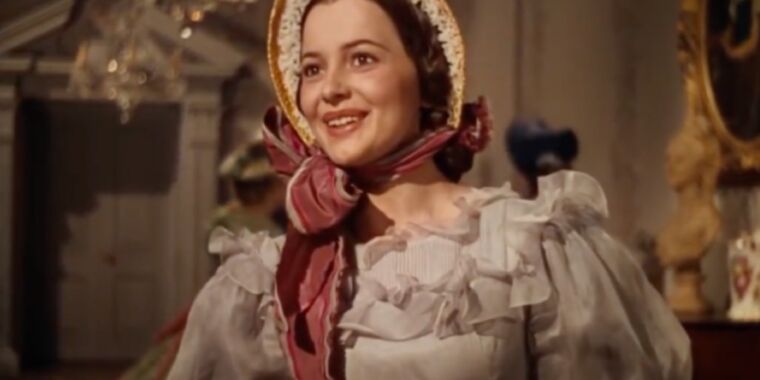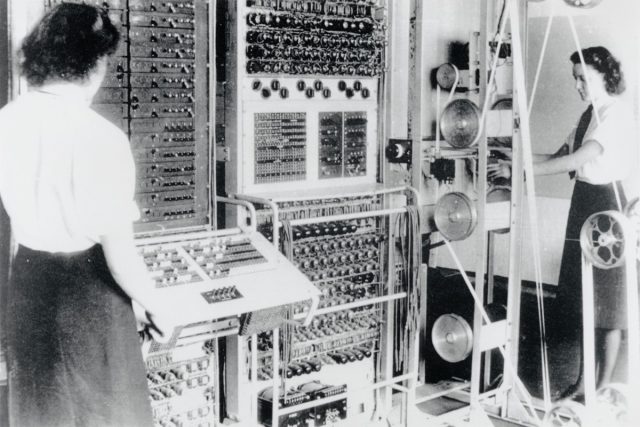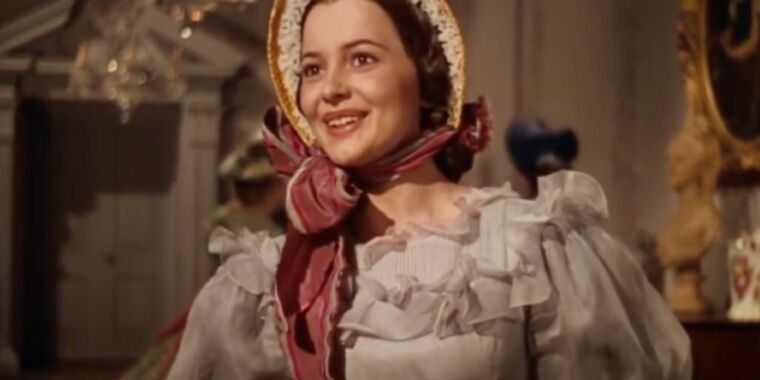
A not-so-Golden Age for women —
The post-system presence of more female producers, directors helped break the cycle.
YouTube/MGM
The so-called Golden Age of Hollywood produced some of the most memorable films ever made, from 1927’s The Jazz Singer to Gone With the Wind (1939) and Citizen Kane (1941). But it wasn’t so golden for women in the film industry, according to a recent paper published in PLOS One that analyzed a century’s worth of data and concluded that the rise of the infamous studio system produced severe gender inequality. Female representation started rising again in the 1950s, after two pivotal lawsuits effectively broke the studios’ stranglehold on the industry.
Lead author Luis Amaral, of Northwestern University, is a physicist by training, specializing in the study of complex systems. This latest work builds on a 2015 study that he co-authored, examining correlations between production budget, box office gross, and total number of user votes for films on the Internet Movie Database (IMDB). That study concluded that the total number of IMDB votes was a strong indicator of a given film’s prominence or notability.
Three years ago, co-author Murielle Dunande, then a high school student spending her summer break in Amaral’s lab, proposed a study of the representation of women in the movies. Initially, she focused on films in the 1960s, but Amaral thought it would be interesting to go back to the birth of the film industry to better understand the historical origins of the gender disparity.
Amaral et al. used data from IMDB, and focused on US films. The IMDB data proved as good, if not better, than the data collected in the American Film Institute Archive, generally considered the gold standard for such records. All told, they analyzed 26,000 movies produced between 1910 and 2010, across all genres (Westerns, musicals, comedy, horror, fantasy, science fiction, action/adventure, romance, etc.), specifically measuring how many women worked in four capacities: as actors, directors, screenwriters, or producers.

Enlarge / Historical trends of gender imbalance in the U.S. movie industry.
Amaral et al, PLOS ONE 2020 (CC BY)
The resulting graphs show a sharp U-shaped pattern, whereby roles for women increased in the first ten years of the 100-year period, and then sharply dropped after 1920. From 1910 to 1920, women accounted for 40 percent of casts, wrote 20 percent of the movies, and produced and directed 5 percent. By 1930, in just ten years, women in casts had dropped by half, and the the number of women producing and directing was nearly zero.
Female representation didn’t start rising until 1950, steadily increasing through 2010. “This is astonishing,” said Amaral. “These things do not happen by accident. They happen because someone is deciding to do things in that way.”
The researchers also factored in as many other variables that they could think of that might have influenced those trends: female representation in the workforce, growth of the industry, GDP growth, the popularity of certain genres, and so forth. “None of them had any impact,” said Amaral. “The things that had an impact on what we saw was changing concentration in the industry, and whether the producers and directors were male or female.”
The pattern they found in the data reminded Amaral of what had happened in the software industry, where women were far more common in the early 1980s, before the industry consolidated and became dominated by just a few players, most notably Microsoft and Apple. In fact, women have a long history working as wartime code-breakers and computer scientists—including Grace Hopper and Margaret Hamilton, among many others—arguably running all the way back to Ada Lovelace.
“It drives me crazy,” Amaral told Ars. “So many people have a very poor knowledge of history, So they make statements like, ‘Oh, all the great computer scientists are men.’ No, they aren’t. There were a lot of women before. So how can you say that? Are you ignorant or dishonest? But that argument never seems to go away.”

Enlarge / A Colossus Mark 2 computer being operated by Dorothy Du Boisson (left) and Elsie Booker in 1943.
Wikimedia Commons/Public domain
Amaral had long pondered the possibility of looking at gender imbalance in a field where arguments about innate ability or natural interest, based on longstanding cultural stereotypes, would (or at least should) be irrelevant. The film industry seemed like a good candidate, since women are generally considered to be interested in the arts, acting, singing, dancing, and the like. “If there is an interest deficit it’s on the side of men,” said Amaral. There’s no lack of talent, either; it’s easy to point to highly accomplished and prominent women in film. So one would expect there to be gender parity, and yet, there is not.
According to Amaral, the US film industry experienced a boom after World War I, because there was no longer much competition from Europe. Those with deeper pockets, and/or better access to capital, began buying other studios, not to mention distribution companies and movie theaters, resulting in a vertical integration where the major studios controlled every aspect of the business. “You made the movies, you distributed the movies, you owned the theaters where the movies were shown,” said Amaral. “So if you wanted to kick out competitors, it was very easy. You just refused to distribute or show their movies.”
Once power became concentrated in a few studios, female representation declined sharply, according to Amaral. “As the studio system lasted, more and more movies were being produced by fewer and fewer players, and these fewer players had more control over everything,” he said. Women received fewer jobs, since male producers hired male directors and male writers.
“There is a connection between increased concentration of power and decreased participation of women.”
Exactly how the studio system foundered is a complicated question, but it’s generally agreed that there were two especially pivotal events that contributed to its downfall. The first was a 1943 lawsuit brought by actress Olivia de Havilland against Warner Bros., seeking to be released from her contract. Bette Davis had mounted a similar legal challenge against Warner Bros. in 1937 and lost. But de Havilland prevailed, resulting in what is still colloquially known as the De Havilland Law in California (Labor Code Section 2855). Although the actress was essentially blacklisted by the studios in revenge for a couple of years, her sister and fellow actress Joan Fontaine once remarked, “Hollywood owes Olivia a great deal.”
Just six years later, the US federal government brought an antitrust lawsuit, known as the Paramount case, arguing that studios shouldn’t be able to both produce and distribute their films and own the theaters in which they were shown. The studios ultimately lost that case when the US Supreme Court ruled against them in May 1948. And once Howard Hughes, who owned a controlling interest in RKO (one of the smaller studios), entered into a consent decree with the federal government to separate the production/distribution and exhibition facets of RKO’s business, the other studios’ counter-arguments fell apart.
“When the studio systems was forced to de-integrate to some extent, many movie stars became producers and directors, and I think that opened the door to greater diversity,” said Amaral. “The legal changes took power away from a handful of men and gave more people the power to start changing the industry.”
He cites the 1980 film 9 to 5 as an example, arguing that it likely would not have been made without Jane Fonda’s star power clout at the time. (Fonda had recently formed her own production company.) In short, “There is a connection between increased concentration of power and decreased participation of women,” said Amaral, adding that the same holds true, a hundredfold, for racial diversity in the film industry.
DOI: PLOS One, 2020. 10.1371/journal.pone.0229662 (About DOIs).









